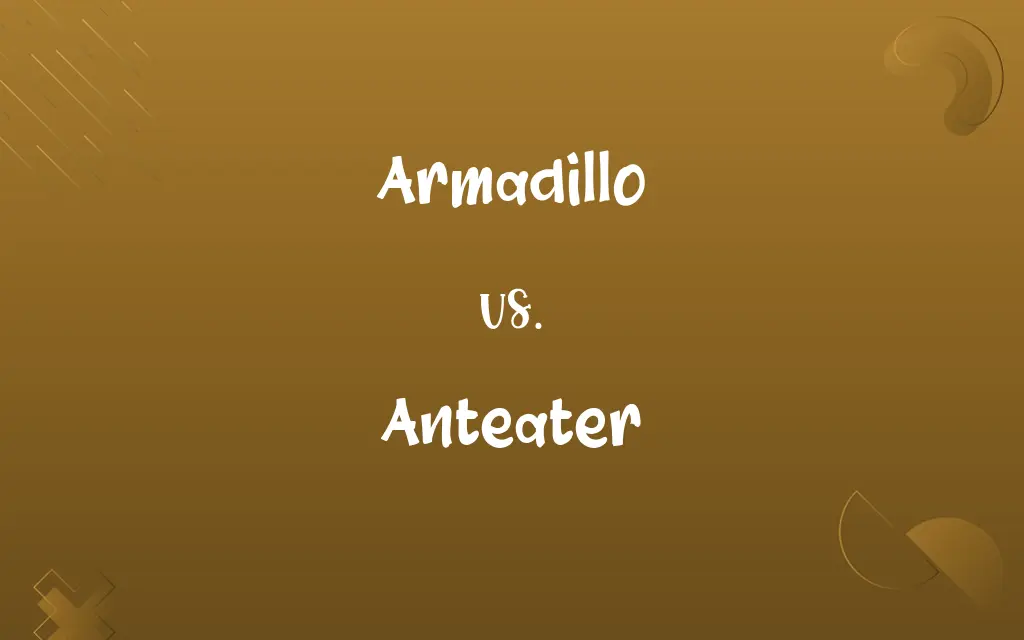Armadillo vs. Anteater: Know the Difference

By Shumaila Saeed || Published on January 21, 2024
Armadillos are armored mammals known for their bony plates, while anteaters are characterized by their long snouts and specialized diet of ants and termites.

Key Differences
Armadillos are unique for their protective armor, consisting of bony plates covering their back, head, legs, and tail. Anteaters, on the other hand, are recognized for their elongated snouts and long, bushy tails.
Shumaila Saeed
Jan 21, 2024
Armadillos are mostly found in the Americas, with a preference for warm, moist environments and are known for their burrowing habits. Anteaters inhabit Central and South American forests and grasslands, spending much of their time foraging for ants and termites.
Shumaila Saeed
Jan 21, 2024
The armadillo's diet is varied, including insects, plants, and small vertebrates. The anteater, however, is specialized in eating ants and termites, using its long, sticky tongue to gather food.
Shumaila Saeed
Jan 21, 2024
Armadillos are known for their unique reproductive system, where some species can delay implantation of the fertilized egg. Anteaters, in contrast, usually give birth to a single offspring, which often rides on the mother's back.
Shumaila Saeed
Jan 21, 2024
Some armadillo species, like the giant armadillo, face threats from habitat loss and hunting. Similarly, anteaters also face challenges from habitat destruction and are considered vulnerable or endangered in some regions.
Shumaila Saeed
Jan 21, 2024
ADVERTISEMENT
Comparison Chart
Habitat
Americas, warm environments
Central and South American forests/grasslands
Shumaila Saeed
Jan 21, 2024
Reproduction
Delayed implantation in some species
Single offspring, carried on back
Shumaila Saeed
Jan 21, 2024
Conservation
Some species vulnerable due to habitat loss
Threatened by habitat destruction
Shumaila Saeed
Jan 21, 2024
ADVERTISEMENT
Armadillo and Anteater Definitions
Armadillo
Mammal with Armor
The Armadillo's armor is a unique adaptation for protection.
Shumaila Saeed
Jan 07, 2024
Anteater
Parental Care
Baby Anteaters ride on their mother's back after birth.
Shumaila Saeed
Jan 07, 2024
Armadillo
Diverse Diet
The Armadillo's diet varies from insects to small mammals.
Shumaila Saeed
Jan 07, 2024
Anteater
Long Snout
The Anteater's long snout is perfect for reaching into ant hills.
Shumaila Saeed
Jan 07, 2024
Armadillo
Reproductive Adaptation
Some Armadillos can delay pregnancy under stress.
Shumaila Saeed
Jan 07, 2024
ADVERTISEMENT
Anteater
Solitary Creature
Anteaters are mostly solitary, wandering through forests.
Shumaila Saeed
Jan 07, 2024
Armadillo
Threatened Species
Certain Armadillo species are threatened due to environmental changes.
Shumaila Saeed
Jan 07, 2024
Anteater
Insectivorous Mammal
Anteaters specialize in eating ants and termites.
Shumaila Saeed
Jan 07, 2024
Armadillo
Burrowing Creature
Armadillos are adept at digging burrows for shelter.
Shumaila Saeed
Jan 07, 2024
Anteater
Endangered Species
Some Anteater species are endangered due to habitat loss.
Shumaila Saeed
Jan 07, 2024
Armadillo
Any of various omnivorous burrowing mammals of the family Dasypodidae, native to southern North America and Central and South America and characterized by an armorlike covering consisting of jointed bony plates.
Shumaila Saeed
Jan 06, 2024
Anteater
Any of several Central and South American mammals of the suborder Vermilingua that lack teeth and feed on ants and termites, especially the giant anteater.
Shumaila Saeed
Jan 06, 2024
Armadillo
Any of the burrowing mammals covered with bony, jointed, protective plates, order Cingulata, found in the Americas, especially in South America.
Shumaila Saeed
Jan 06, 2024
Anteater
Any of several other animals, including the echidna, aardvark, and pangolin, that feed on ants.
Shumaila Saeed
Jan 06, 2024
Armadillo
Any edentate animal if the family Dasypidæ, peculiar to America. The body and head are incased in an armor composed of small bony plates. The armadillos burrow in the earth, seldom going abroad except at night. When attacked, they curl up into a ball, presenting the armor on all sides. Their flesh is good food. There are several species, one of which (the peba) is found as far north as Texas. See Peba, Poyou, Tatouay.
Shumaila Saeed
Jan 06, 2024
Anteater
Any of several animals of South and Central America, in suborder Vermilingua, which are noted for eating ants and termites which they catch with their long sticky tongues.
Shumaila Saeed
Jan 06, 2024
Armadillo
Burrowing chiefly nocturnal mammal with body covered with strong horny plates
Shumaila Saeed
Jan 06, 2024
Anteater
Any of some other not closely related species that feed with ants, including pangolin (scaly anteater), echidna (spiny anteater), aardvark and numbat (banded anteater).
Shumaila Saeed
Jan 06, 2024
Anteater
Toothless mammal of southern Africa and Asia having a body covered with horny scales and a long snout for feeding on ants and termites
Shumaila Saeed
Jan 06, 2024
Anteater
Any of several tropical American mammals of the family Myrmecophagidae which lack teeth and feed on ants and termites
Shumaila Saeed
Jan 06, 2024
Anteater
Nocturnal burrowing mammal of the grasslands of Africa that feeds on termites; sole extant representative of the order Tubulidentata
Shumaila Saeed
Jan 06, 2024
Anteater
Small Australian marsupial having long snout and strong claws for feeding on termites; nearly extinct
Shumaila Saeed
Jan 06, 2024
Anteater
Burrowing spine-covered monotreme of Australia having a long snout and claws for hunting ants and termites
Shumaila Saeed
Jan 06, 2024
Repeatedly Asked Queries
What do Armadillos eat?
Armadillos eat insects, plants, and small vertebrates.
Shumaila Saeed
Jan 21, 2024
Are Armadillos social animals?
Armadillos are generally solitary, except during mating.
Shumaila Saeed
Jan 21, 2024
What is the habitat of Anteaters?
Anteaters inhabit Central and South American forests and grasslands.
Shumaila Saeed
Jan 21, 2024
How do Anteaters defend themselves?
Anteaters use their strong claws for defense.
Shumaila Saeed
Jan 21, 2024
How do Armadillos protect themselves?
Armadillos use their armor plates for protection.
Shumaila Saeed
Jan 21, 2024
Can Armadillos roll into a ball?
Only some Armadillo species can roll into a ball for defense.
Shumaila Saeed
Jan 21, 2024
What is the habitat of Armadillos?
Armadillos live in the Americas, preferring warm, moist environments.
Shumaila Saeed
Jan 21, 2024
How long is an Armadillo's lifespan?
Armadillos typically live for 12-15 years in the wild.
Shumaila Saeed
Jan 21, 2024
How long is an Anteater's lifespan?
Anteaters can live up to 15 years in the wild.
Shumaila Saeed
Jan 21, 2024
Are Armadillos endangered?
Some Armadillo species are threatened or endangered.
Shumaila Saeed
Jan 21, 2024
Are Anteaters endangered?
Some Anteater species, like the Giant Anteater, are considered vulnerable or endangered.
Shumaila Saeed
Jan 21, 2024
How do Anteaters reproduce?
Anteaters give birth to a single offspring, which is often carried on the mother's back.
Shumaila Saeed
Jan 21, 2024
What is unique about Armadillos' shell?
Armadillos have a hard shell made of bony plates for protection.
Shumaila Saeed
Jan 21, 2024
What is unique about Anteaters' tongue?
Anteaters have a long, sticky tongue to capture ants and termites.
Shumaila Saeed
Jan 21, 2024
Do Anteaters climb trees?
Yes, some Anteater species, like the Tamandua, can climb trees.
Shumaila Saeed
Jan 21, 2024
How do Armadillos reproduce?
Armadillos mate and can have delayed implantation of embryos.
Shumaila Saeed
Jan 21, 2024
Share this page
Link for your blog / website
HTML
Link to share via messenger
About Author
Written by
Shumaila SaeedShumaila Saeed, an expert content creator with 6 years of experience, specializes in distilling complex topics into easily digestible comparisons, shining a light on the nuances that both inform and educate readers with clarity and accuracy.








































































